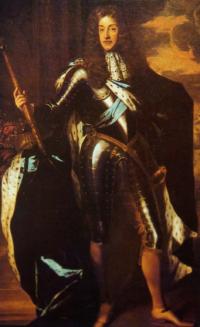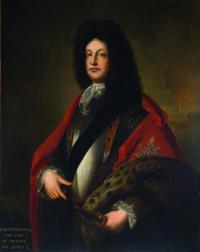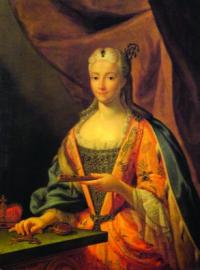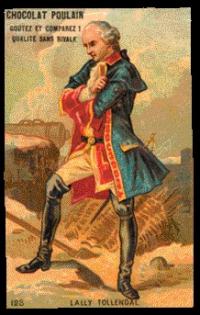‘Fighting Dick’ Talbot, ‘the Chevalier’ Wogan and Lally-Tollendal jailbreakers and jailbirds
Published in 18th–19th - Century History, Early Modern History (1500–1700), Features, Issue 2(March/April 2011), Volume 19
James II—dismissed by James Connolly (Labour in Irish history [1911]) as ‘the most worthless representative of the most worthless race ever to sit on a throne’. (City of Manchester Art Gallery)
Richard Talbot
It is appropriate to begin any discussion of Irish Jacobite prisoners with Richard Talbot, the most illustrious of Irish Jacobites and a veritable Harry Houdini within their ranks. As a youthful cornet in General Thomas Preston’s Leinster army, Talbot fell into parliamentary hands after the battle of Dungan’s Hill on 8 August 1647—a fortunate fate, given that Colonel Michael Jones’s soldiers cut the throats of between three and five thousand of the vanquished Confederates after they had laid down their arms and sought terms. He later served with Sir Arthur Ashton, the one-legged governor of Drogheda, when the town fell to Cromwell on 11 September 1649. Sir Arthur was beaten to death with his own wooden leg, and his garrison and many of the town’s inhabitants were put to the sword. Talbot spent three days lying wounded among the slain.
Undaunted after this one-sided encounter with ‘Old Noll’, he put himself forward to assassinate the lord protector in 1655. Subsequently arrested and interrogated by Cromwell himself, he managed to get his guards drunk, ‘slipped down to the Thames by a cord’ and escaped both the Tower and the hangman’s noose.
On the restoration of Charles II in 1660, Irish Catholics employed Talbot to advance their proposals for a new

Richard Talbot, duke of Tyrconnell—a veritable Harry Houdini. (National Gallery of Ireland)
land settlement. His zeal, aggression and hostility towards the 1st duke of Ormond, lord lieutenant of Ireland, the ‘unkinde deserter’ of Irish Jacobite letters, landed him in the Tower and Dublin’s Newgate on three further occasions. Within a month of James II’s accession to the throne in February 1685, however, Ormond was recalled and his regiment given to Talbot, who was also elevated to the peerage as earl of Tyrconnell. Tyrconnell moved quickly to purge the Irish polity, army and judiciary of what he deemed an undesirable Puritan and crypto-Cromwellian element, a move that facilitated the wholesale Catholicisation of the army, judiciary and local government.
Political events in England, however, quickly stifled his reforming zeal. English Protestant distaste for James’s exertions on behalf of his Catholic subjects and the birth of a legitimate Catholic heir in 1688 precipitated the invasion of his son-in-law, William, prince of Orange. James’s subsequent flight to France led the English parliament to declare his abdication, enabling it to bestow the crown jointly on William and his wife Mary, James’s eldest daughter.
William arrived in Ireland on 14 June 1690 and prepared to do battle for the Irish crown. At the battle of the Boyne (1 July 1690) Tyrconnell behaved with great valour in the rearguard action at Oldbridge. Despite his subsequent unpopularity among the Irish Jacobites, a consequence of his rivalry with Patrick Sarsfield, Henry Luttrell and the ‘war party’, Tyrconnell retained the utmost confidence of his exiled king. He eventually expired inside Limerick’s walls, Ireland’s largest open prison, during the second siege (1691). A long, chequered, charmed and swaggering career of dalliances, duels, audacious escapes and near-death experiences set an almost unattainable standard for his defeated, exiled Irish Jacobite successors.
Princess Clementina, second daughter of the exiled king of Poland, James Sobieski. The charismatic Wogan persuaded her to marry his master, the Old Pretender ‘James III’, but later had to rescue her from imprisonment by the Holy Roman Emperor. (Scottish National Portrait Gallery)

Princess Clementina, second daughter of the exiled king of Poland, James Sobieski. The charismatic Wogan persuaded her to marry his master, the Old Pretender ‘James III’, but later had to rescue her from imprisonment by the Holy Roman Emperor. (Scottish National Portrait Gallery)
Chevalier Wogan and the rescue of the Princess Clementina
Nevertheless, Sir Charles ‘the Chevalier’ Wogan, soldier, Jacobite, man of letters, nephew and champion of ‘Fighting Dick’ Talbot, not only trumped his illustrious uncle but did so on a pan-European stage. Another of Wogan’s kinsmen, Colonel Edward Wogan, royalist pimpernel and martyr, had saved the life of Charles II after the battle of Worcester (1651), thereby copper-fastening young Wogan’s impeccable cavalier credentials. Sir Charles would himself intervene spectacularly in preserving one of Europe’s oldest royal families.
At the tender age of seventeen, Wogan participated in the abortive 1715 attempt to restore ‘James III’. Imprisoned in Newgate after the surrender of the Jacobite army and later transferred to Westminster Hall (April 1716) to be tried for high treason, he escaped and made his way to the Continent under attainder and with a price of £500 on his head. He joined the Jacobite regiment of his cousin Arthur Dillon, in the French service, but left after a year for the papal state of Avignon, where he became a secret agent of the exiled Stuart king. Later that year he accompanied James Butler, 2nd duke of Ormond, to Russia to help forge an alliance between Peter the Great and Charles XII of Sweden against their common enemy George I and in support of the Stuarts. He also tried to negotiate a marriage between James Stuart and Anna, duchess of Courland and niece of the Tsar, but political expediency and fate hindered a union between the fiery empress and the stoical pretender. (Russia had had its fill of ‘pretenders’ and ‘false Dimitris’!)
His match-making finally took him to Ohlau, in the Holy Roman Empire, residence of James Sobieski, exiled king of Poland and son of the warrior-king Jan Sobieski III, who had saved Vienna from the Turks in 1682. The charming, charismatic Wogan made a great impression on Sobieski’s second daughter, Clementina, who accepted his master’s marriage proposal. George I could not countenance a union between his rival and a princess of such an illustrious family, and he persuaded the Holy Roman Emperor Charles V to imprison the wedding party at Innsbruck, deep within imperial territory. Wogan persuaded Pope Clement XI, godfather of the bride, her intended groom, James III, and James Sobieski to allow him to attempt the princess’s rescue.
Along with his uncle Richard Gaydon, Capt. Lucius O’Toole and Capt. John Misset and his heavily pregnant wife (as a companion for Clementina), Wogan subsequently defied contemporary logistics and atrocious weather conditions in the Brenner Pass by snatching the heavily guarded princess from under the noses of the imperial authorities. On their arrival in Rome, Wogan became the talk and toast of Europe. Pope Clement XI made him a senator of Rome, the highest civil honour the city could bestow, while James III dubbed him a knight-baronet with a colonel’s commission and he served as a witness at James’s wedding. This audacious rescue was the subject of a forgettable Hollywood B-movie, The iron glove (1954). Directed by William Castle, ‘the King of Gimmick’, it ‘starred’ ‘Straight-Shooting’ Robert Stack in the lead role as Sir Charles Wogan.
Wogan spent the rest of his military career in the Spanish service, fighting the Moors in the Maghreb, and distinguished himself at Oran and Santa Cruz in the 1730s. Philip V rewarded him with the governorship of La Mancha, an appropriate tribute to the most famous knight in Europe. This honour, however, in no way eclipsed his affection for Ireland, where he, as he informed his exiled king, ‘should have a better estate at home than ever his [Don Quixote’s] fathers enjoyed, and a tomb too where no man of honour may be ashamed to lie’. Wogan is probably best remembered for his correspondence with Jonathan Swift, in which he railed at English injustices against the Irish and French ingratitude for Irish military service to their country. Swift reciprocated with generous commendation for the Irish regard for the Irish:
‘Yet I cannot but highly esteem those gentlemen of Ireland, who with all the disadvantages of being exiles and strangers, have been able to distinguish themselves by their valour and conduct in so many parts of Europe, I think above all other nations, which ought to make the English ashamed of the reproaches they cast on the ignorance, the dullness, and the want of courage, in the Irish natives . . . But the millions of oppressions they lie under, the tyranny of their landlords, the ridiculous zeal of their priests, and the general misery of the whole nation, have been enough to damp the best spirits under the sun.’
Thomas Arthur Lally, compte de Tollendal, as depicted on a nineteenth-century promotional card by French chocolate manufacturer Chocolat Poulain. (Bernard Share)

Thomas Arthur Lally, compte de Tollendal, as depicted on a nineteenth-century promotional card by French chocolate manufacturer Chocolat Poulain. (Bernard Share
Thomas Arthur Lally
Swift could have been referring to Thomas Arthur Lally, compte de Tollendal, who occupies the ‘Jacobite twilight’, the interface between Jacobitism and Jacobinism. Indeed, his Jacobite background, chequered martial career and tragic end provide a fascinating microcosm of the complex, interconnected struggles for dynastic, political, diplomatic and military hegemony between Irish Catholics and Protestants, Hanoverian and Stuart royalism and French–British imperialism. His intrigues and travails followed a broad trajectory from the west of Ireland, through the home counties of England, the Lowlands and Highlands of Scotland, to the Iberian Peninsula, the Imperial territories, the Baltic states and the Russian steppe, providing a fitting testimony to the mobility, cultural fluidity and political vulnerability of the exiled Irishman in eighteenth-century Europe. Lally’s gradual rise and spectacular fall in French military and political life maps a political and military journey from the Boyne and Aughrim, where his father had served King James, to the battlefields and battlements of Dettingen, Fontenoy, Lauffelt, Bergen-op-Zoom, Madras, Pondicherry and Wandewash, to the executioner’s block at the Place de Grève.
Having covered himself in glory in the French service during the War of the Austrian Succession, Lally grasped the opportunity to revive flagging French political and military fortunes on the Indian subcontinent during the Seven Years’ War (1756–63). Hampered by political infighting, starved of the sinews of war by the corrupt officials of the French East Indian Company and undermined by treacherous and indolent subordinates, Lally failed to stem the British tide and was forced to surrender Madras (1758) and Pondicherry (1761) to his Irish-born antagonist, Major-General Sir Eyre Coote, and was taken prisoner to London.
On being informed of the storm brewing against him in France, he petitioned Prime Minister Pitt (the Elder) for permission to return and face his accusers. Choiseul, the French minister of war, initially attempted to effect a reconciliation between Lally and his (Choiseul’s) own in-law, Bussy. On 1 November 1765, however, he issued a lettre de cachet committing Lally to the Bastille, where he was later executed (May 1766) for betraying the interests of the king, the state and the Company of the Indies. To his natural son, Gerald, the martyred father committed the vindication of his memory. The youth employed Voltaire’s formidable pen and his Fragments sur l’Inde (1773)—the forerunner of Emile Zola’s J’Accuse—branded Lally’s death ‘a murder committed with the sword of justice’.
In May 1778 Louis XVI and his council finally relented, undoing his father’s previous injustice, and the young Lally would, in turn, offer to defend Louis XVI when the king was put on trial after the outbreak of the French Revolution. He later fled Paris and proceeded to London, where he befriended Edmund Burke, cheerleader of the American Revolution and staunch critic of its French counterpart. During his sojourn in London, he penned a tragedy and full-length biography of Thomas Wentworth, earl of Strafford (1593–1641), a parallel tale of a loyal servant who was himself sacrificed on the altar of political expediency. Gerald Lally returned to France on the restoration of Louis Philippe and became count and marquis of Lally-Tollendal, peer of France, minister of state, grand officer of the Legion d’Honneur, treasurer of the Order of St Esprit and member of the Royal Academy of France. HI
Éamonn Ó Ciardha is a senior lecturer in the School of English, History and Politics, University of Ulster, and is Gastprofessor Europaicum, Universität des Saarlandes, Saarbrücken, Germany, for 2010–11.
Further reading:
T. Canavan, ‘Making a hole in the moon: the rescue of Princess Clementina’, History Ireland (Winter 1993).
P. Clarke de Dromantin, Les réfugiés jacobites dans la France du xviie siècle (Bordeaux, 2005).
É. Ó Ciardha, Ireland and the Jacobite cause, 1685–1766: a fatal attachment (Dublin, 2002; repr. 2004).
P. Sergeant, Little Jennings and Fighting Dick Talbot: a life of the duke and duchess of Tyrconnel (2 vols) (London, 1913).
















